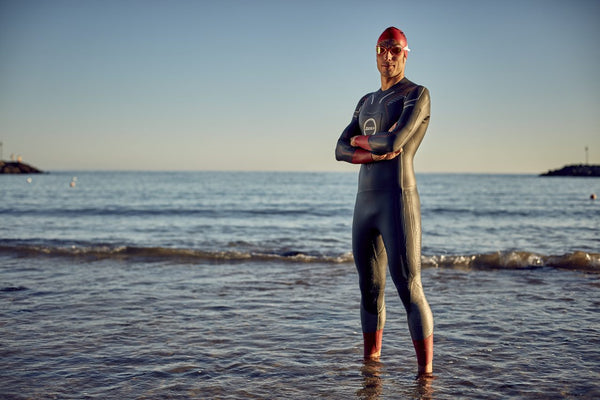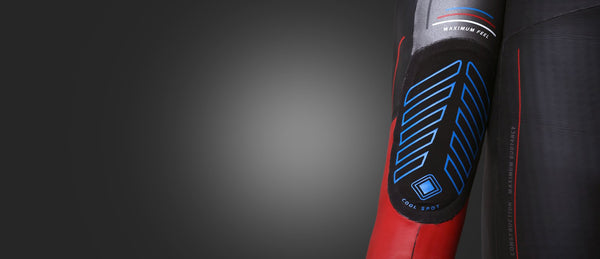What makes a Triathlon wetsuit different?Updated 2 months ago
Triathlon wetsuits started being developed in the late 80s by Ironman athlete Dan Empfield. He set about creating a suit that would help him swim faster through the water and also out of transition. Triathlon wetsuits have come a long way over the last 40 years, with technology continually innovating design and what’s possible.
What makes triathlon wetsuits different?
Wetsuits were first developed for diving and water-sports, designed to provide warmth in the water. Traditional wetsuits are generally thicker for added insulation with a tougher, more rugged outer to cope with the wear and tear. The thicker neoprene is quite restrictive and difficult to remove but this isn’t as crucial a design feature.
Triathlon wetsuits are designed with both of these attributes but also flexibility, hydrodynamic resistance and ease of removal (in transition). Their construction is very different to a surfing wetsuit, with a significantly higher number of panels and varying neoprene thickness to ensure maximum flexibility through the shoulders, buoyancy to elevate the body position in the water and thermal protection.

The Vanquish (above) utilises a 9-panel construction.
Flexibility can vary significantly between each different suit. It’s important to move through the water as economically as possible rather than fighting against the suit with every arm rotation. Every movement that is competing with resistance unnecessarily saps energy, affects technique and lowers efficiency. All Zone3 suits offer a ‘spring loaded’ shoulder design to generate a more rhythmic swim stroke. This enables faster and more energy efficient swimming.

Beginner Triathlon Wetsuits vs Elite Triathlon Wetsuits
Higher-end wetsuits tend to be thinner, as they are designed with more elite athletes in mind. An entry level suit will often provide greater warmth and buoyancy but reduced flexibility. Maximum wetsuit thickness for competitive triathlons is 5mm to help reduce the risk of overheating. Also, wetsuits are only permitted when the water temperature is below 21C for this very reason.
All our suits contain a mix of different neoprene thicknesses, to achieve the perfect balance. Our ‘Measured Buoyancy’ provides optimum efficiency, for all level athletes.
The Vanquish, designed for more elite athletes, features super thin 1.5mm neoprene to five unparalleled flexibility through the shoulders, arms, chest and back.
Our entry-level Advance suit uses 2mm neoprene with a 3mm chest and back panel. Thicker 5mm neoprene on the torso, hips and legs help with buoyancy and position in the water.

Aeroforce Sensory Forearm Catch Panel on the Vanquish.
Types of Neoprene
There’s a variety of different neoprene available, with our suits using a combination of ‘Extreme Flex’, ‘Speedflo’ and ‘Smoothskin’ fabrics, as well as Yamamoto #39 and #40 cell SCS Nano. Yamamoto rubber is a premium, high performance neoprene. Yamamoto #40 is the newest, most flexible and buoyant neoprene available. It has extreme stretch properties, which make it perfect for areas where free movement is crucial.
As well as being thinner, the outer surface of the neoprene used for a triathlon wetsuit is slicker with high hydrodynamic resistance to reduce drag. The smooth, engineered surface is super-efficient through the water. This helps to ensure a competitive edge and significantly reduces swim times. Zone3 suits are coated with an aqua dynamic covering, which significantly minimises any drag through the water whilst also improving the suits durability.

Ease of Removal
The final key design difference between a triathlon wetsuit and water-sports wetsuit is its ease of removal. Transitions are the 4th discipline in a triathlon. They can be the difference between winning and losing. We know how important it is to get out of the water and onto the bike as quickly as possible. So, we have put a lot of design effort into this. All Zone3 wetsuits feature ‘Pro Speed’ arm and leg cuffs which use a specially formulated silicone coating to make sure the wetsuit comes off as quick as possible. We also use downwards zips on all of our wesuits too. This helps make it even easier to get the back open.

So, in a nutshell…
You could wear a water-sports wetsuit for a triathlon, although you will find it significantly harder both during the swim and also getting it off in transition. A water-sports suit is likely to be enough of a hindrance that you won’t need to worry about being in the mix for the medals. However, if you do find yourself there or thereabouts, you may not even be eligible to claim your reward if your surfing suit is over 5mm thick (depending on race regulations).
